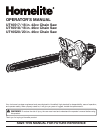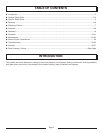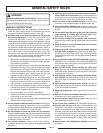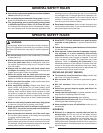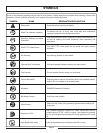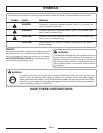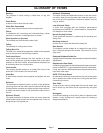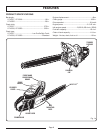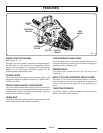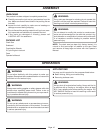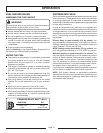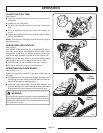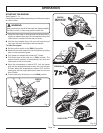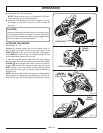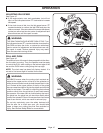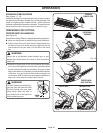
Page 4
SPECIFIC SAFETY RULES
WARNING:
The warnings, labels, and instructions found in this sec-
tion of the operator’s manual are for your safety. Failure
to follow all instructions may result in serious personal
injury.
Do not cut vines and/or small underbrush (a diameter
of less than 3 in.).
Muffler surfaces are very hot during and after opera-
tion of the chain saw; keep all body parts away from
the muffler. Serious burns may occur if contact is made
with the muffler.
Always hold the chain saw with both hands when
the engine is running. Use a firm grip with thumbs and
fingers encircling the chain saw handles.
Never let anyone use the chain saw who has not
received adequate instructions in its proper use. This
applies to rentals as well as privately owned saws.
Before you start the engine, make sure the saw chain
is not contacting any object.
Wear snug-fitting clothing. Always wear heavy, long
pants, boots, and gloves. Do not wear jewelry, short
pants, sandals, or go barefoot. Do not wear loose fitting
clothing, which could be drawn into the engine or catch
the chain or underbrush. Wear overalls, jeans, or chaps
made of cut-resistant material or ones that contain cut-
resistant inserts. Secure hair so that it is above shoulder
level.
Wear non-slip safety footwear and heavy-duty gloves
to improve your grip and to protect your hands.
Wear eye protection which is marked to comply with
ANSI Z87.1, as well as hearing and head protection,
when operating this equipment.
Keep bystanders and animals out of the work area.
Do not allow other persons to be nearby during starting
or cutting with the chain saw.
NOTE: The size of the work area depends on the job being
performed as well as the size tree or workpiece involved.
For example, felling a tree requires a larger work area than
making other cuts (i.e., bucking cuts, etc.).
Keep SAFE-T-TIP anti-kickback nose guard properly
mounted on the guide bar to prevent rotational kick-
back.
Follow the sharpening and maintenance instructions
for the saw chain.
Never operate a chain saw that is damaged, improp-
erly adjusted, or is not completely and securely
assembled. Be sure that the saw chain stops moving
when the throttle control trigger is released. If the saw
chain moves at idle speed, the carburetor may need
adjusting. Refer to Adjusting the Carburetor in the
Maintenance section of this manual. If the saw chain still
moves at idle speed after adjustment has been made,
contact an authorized service center for adjustment and
discontinue use until the repair is made.
REFUELING (DO NOT SMOKE!)
To reduce the risk of fire and burn injury, handle fuel
with care. It is highly flammable.
Mix and store fuel in a container approved for gaso-
line.
Mix fuel outdoors where there are no sparks or
flames.
Select bare ground, stop the engine, and allow it to
cool before refueling.
Loosen the fuel cap slowly to release pressure and to
keep fuel from escaping around the cap.
Tighten the fuel cap securely after refueling.
Wipe spilled fuel from the unit. Move 30 feet away from
refueling site before starting engine.
Never attempt to burn off spilled fuel under any cir-
cumstances.
KICKBACK
Kickback is a dangerous reaction that can lead to
serious injury. Do not rely only on the safety devices
provided with the saw. As a chain saw user, you must
take special safety precautions to help keep your cut-
ting jobs free from accident or injury. See the General
Safety Rules and Operation sections of this manual for
added information on kickback and how to avoid serious
personal injury.
GENERAL SAFETY RULES
Use only the replacement guide bars and low kickback
chains specified for the saw.
Do not adapt the powerhead to a bow guide or use it to
power any attachments or devices not listed for the saw.
The gas powered saw (or electrically powered saw)
is classified by CSA as a Class 1C (or Class 2C) saw.
It is intended for infrequent use by homeowners, cottag-
ers, and campers, and for such general applications as
clearing, pruning, cutting firewood, etc. It is not intended
for prolonged use. Prolonged periods of operation can
cause circulatory problems in the user’s hands due to
vibration. For such use, it may be appropriate to use a
saw having an anti-vibration feature.
Save these instructions. Refer to them frequently and
use to instruct other users. If you loan someone this tool,
loan them these instructions also.



